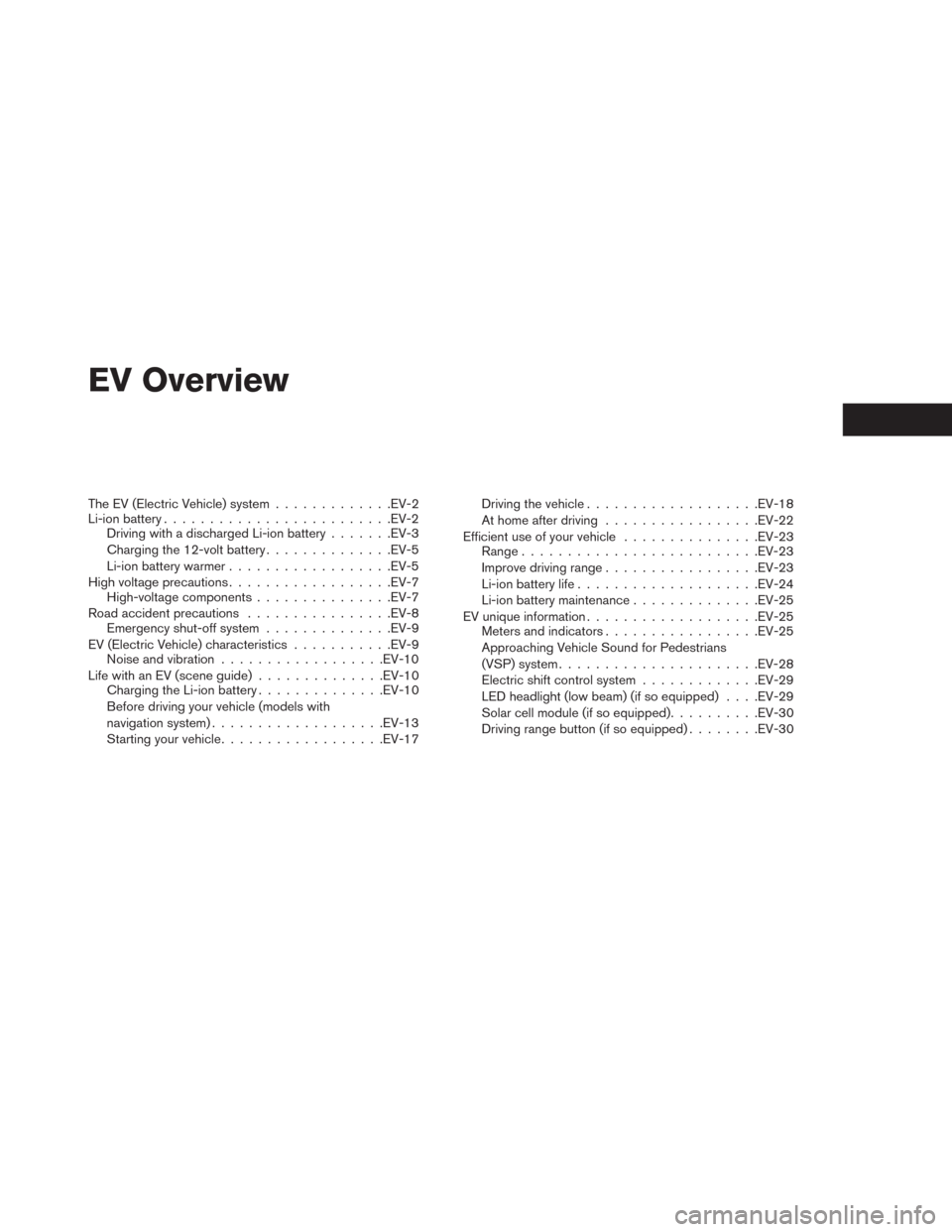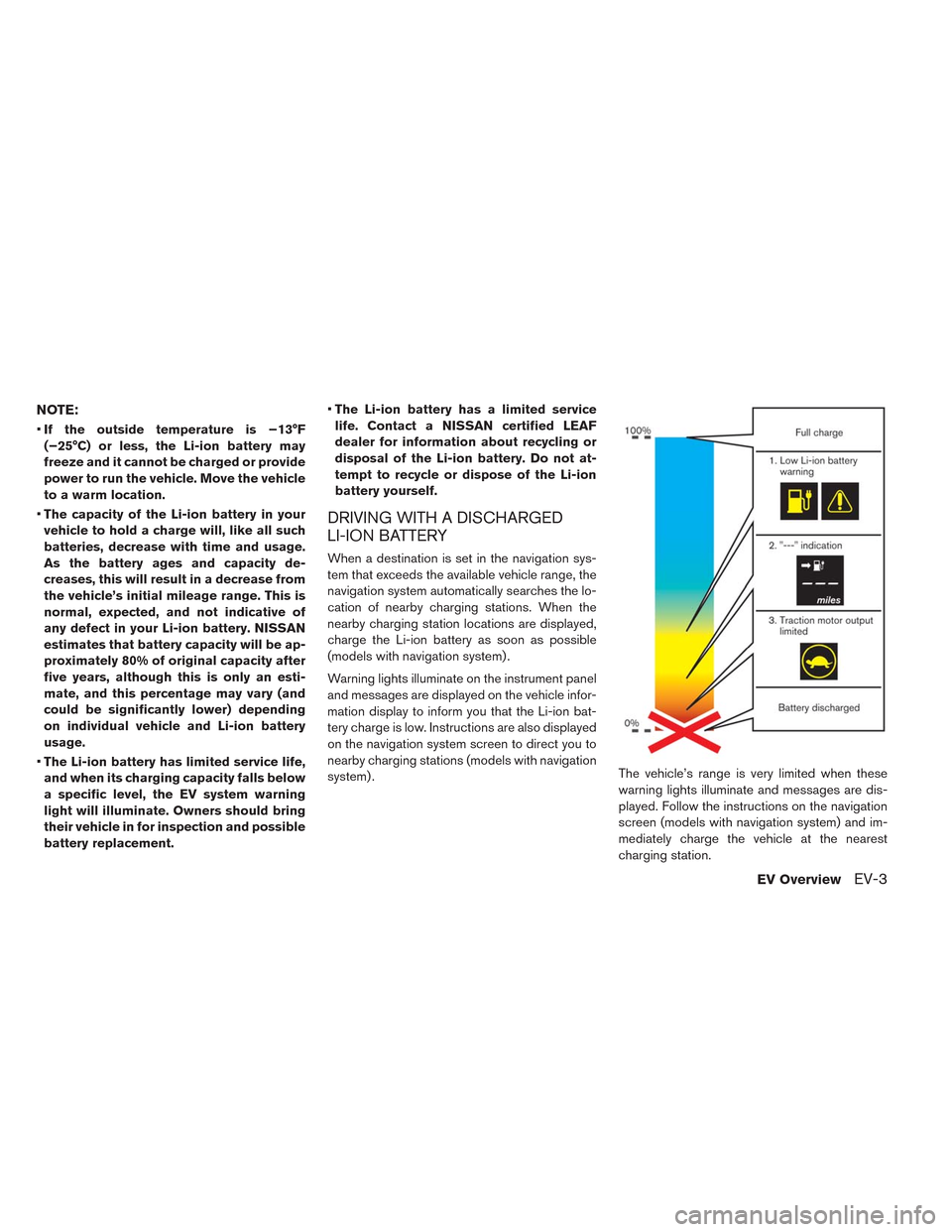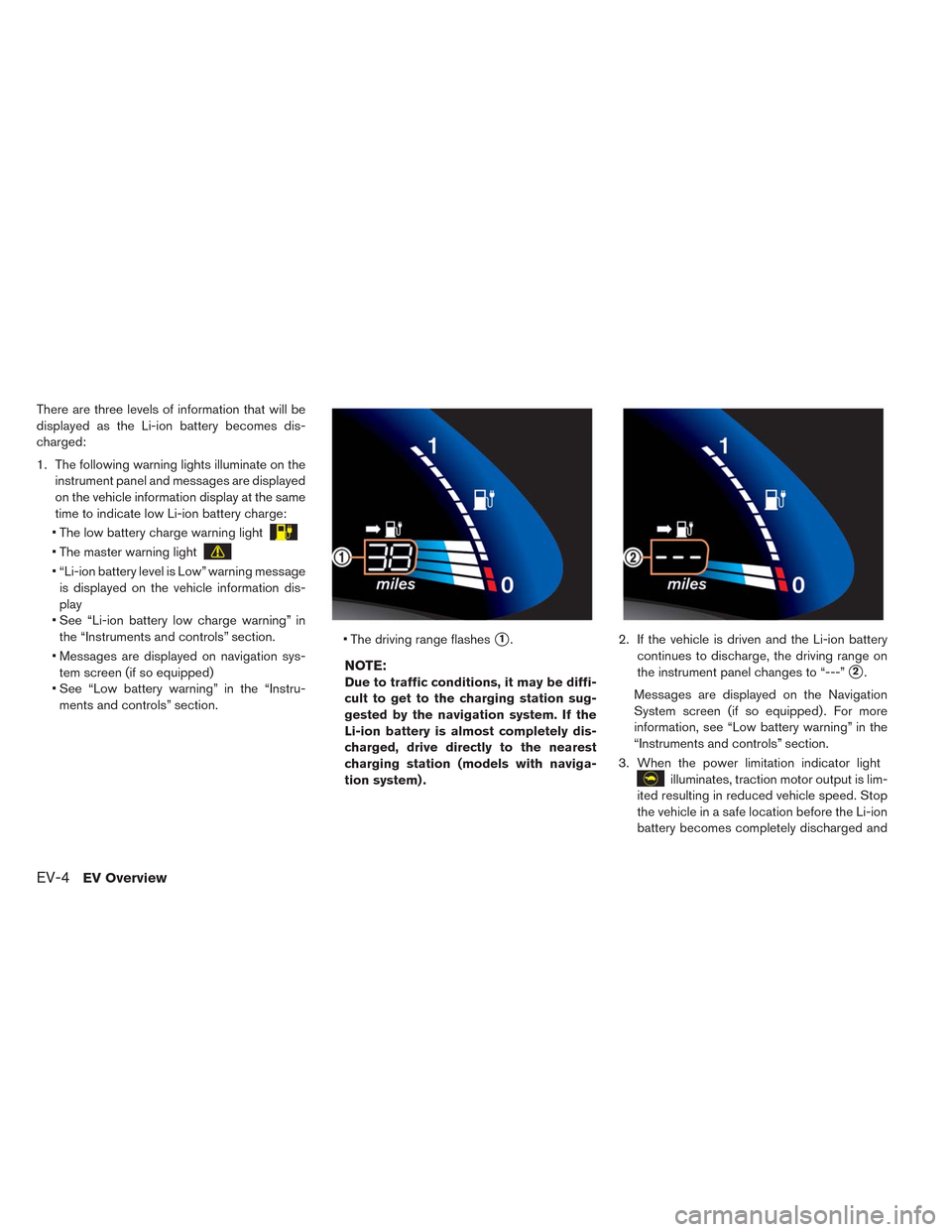Page 11 of 397
1. Charge port lid (P 3-18)
2. Hood (P 3-16)
3. Headlight and turn signal lights
— Switch operation (P 2-43)
— Bulb replacement (P 8-22)4. Windshield wiper and washer
— Switch operation (P 2-39)
— Blade replacement (P 8-13)
— Window washer fluid (P 8-11)
5. Side camera (if so equipped) (See LEAF
Navigation System Owner’s Manual.)
6. Outside mirrors (P 3-23)7. Power windows (P 2-55)
8. License plate installation (P 9-9)
9. Front camera (if so equipped) (See LEAF
Navigation System Owner’s Manual.)
10. Recovery hook (P 6-14)
11. Fog lights*
— Switch operation (P 2-45)
— Bulb replacement (P 8-23)
12. Tires
— Wheels and tires (P 8-26, P. 9-6)
— Flat tire (P 6-3)
— Tire Pressure Monitoring System (TPMS)
(P 2-17, P. 5-2)
13. Doors
— Keys (P 3-2)
— Door locks (P 3-3)
— NISSAN Intelligent Key® system (P 3-6)
— Security system (P 2-36)
14. Child safety rear door lock (P 3-6)
EXTERIOR FRONT
Illustrated table of contents0-3
Page 12 of 397
1. Rear view camera* (See LEAF Navigation
System Owner’s Manual.)
2. Rear window wiper and washer
— Switch operation (P 2-41)
— Window washer fluid (P 8-11)3. High-mounted stop light
— Bulb replacement (P 8-23)
4. Rear window defroster (P 2-42)
5. Solar cell module* (P EV-30)6. Antenna (P 4-42)
— Satellite radio antenna (See LEAF Naviga-
tion System Owner’s Manual.)
7. Rear combination lights
— Bulb replacement (P 8-23)
8. Rear hatch (P 3-17)
— NISSAN Intelligent Key® system (P 3-6)
EXTERIOR REAR
0-4Illustrated table of contents
Page 13 of 397
1. Ceiling light (P 2-58)
2. Sun visors (P 3-20)
3. Map lights (P 2-58)
— Bluetooth® Hands-Free Phone System
microphone (See LEAF Navigation System
Owner’s Manual.)4. Sunglasses holder (P 2-52)
5. Inside rearview mirror (P 3-21)
— HomeLink®* (if so equipped) (P 2-59)6. Cargo area
— Cargo cover* (if so equipped) (P 2-53)
— EVSE (Electric Vehicle Supply Equipment)
(P CH-11)
7. Tools (P 6-12)
8. Heated seat switch (P 2-47)
9. Console box (P 2-53)
10. Door armrest
— Power window switch (P 2-55)
— Power door lock switch (P 3-5)
— Outside mirror remote control switch
(P 3-23)
11. Front cup holders (P 2-51)
PASSENGER COMPARTMENT
Illustrated table of contents0-5
Page 14 of 397
1. TRIP switch for twin trip odometer (P 2-6)
2. Trip computer switch (P 2-28)3. Instrument brightness control switch
(P 2-42)4. Headlight, fog light (if so equipped) and
turn signal switch
— Headlight (P 2-43)
— Turn signal light (P 2-45)
— Fog light (if so equipped) (P 2-45)
5. Steering-wheel-mounted controls (left side)
(See LEAF Navigation System Owner’s
Manual.)
—
Driving range button (if so
equipped)
— Audio control
— Bluetooth® Hands-Free Phone System
control
6. Steering wheel
— Power steering system (P 5-19)
— Horn (P 2-47)
— Driver’s supplemental air bag (P 1-35)
7. Wiper and washer switch (P 2-39)
8. Steering-wheel-mounted controls (right
side)
— Cruise control switches (P 5-15)
— ECO button (if so equipped) (P 2-47)
9. Fuse box cover (P 8-16)
10. Heated steering wheel (if so
equipped)(P 2-46)
11. Vehicle Dynamic Control (VDC) OFF
switch (P 2-49)
12. Charge timer OFF switch(P 2-50)
COCKPIT
0-6Illustrated table of contents
Page 16 of 397
1. Side vents (P 4-6)
2. Meters and gauges (P 2-5)
3. Center multi-function control panel (See
LEAF Navigation System Owner’s Manual.)
— Navigation system
— Vehicle information and setting buttons— Bluetooth® Hands-Free Phone System
— Audio system
4. Hazard warning flasher switch (P 6-2)
5. Center vents (P 4-6)
6. Rear window defroster switch (P 2-42)
7. Front passenger supplemental air bag
(P 1-35)8. Hood release handle (P 3-16)
9. Power switch (P 5-7)
10. iPod® connector/USB connector (See
LEAF Navigation System Owner’s Manual.)
11. Power outlet (P 2-50)
12. Auxiliary input jack (See LEAF Navigation
System Owner’s Manual.)
13. Front passenger air bag status light/
(P 2-20)/Approaching Vehicle Sound for
Pedestrians (VSP) system warning light
(P 2-15)
14. Heater and air conditioner control (P 4-7)
15. Glove box (P 2-53)
INSTRUMENT PANEL
0-8Illustrated table of contents
Page 21 of 397

EV Overview
The EV (Electric Vehicle) system.............EV-2
Li-ion battery.........................EV-2
Driving with a discharged Li-ion battery.......EV-3
Charging the 12-volt battery..............EV-5
Li-ion battery warmer..................EV-5
High voltage precautions..................EV-7
High-voltage components...............EV-7
Road accident precautions................EV-8
Emergency shut-off system..............EV-9
EV (Electric Vehicle) characteristics...........EV-9
Noise and vibration..................EV-10
Life with an EV (scene guide)..............EV-10
Charging the Li-ion battery..............EV-10
Before driving your vehicle (models with
navigation system)...................EV-13
Starting your vehicle..................EV-17Driving the vehicle...................EV-18
At home after driving.................EV-22
Efficient use of your vehicle...............EV-23
Range..........................EV-23
Improve driving range.................EV-23
Li-ion battery life....................EV-24
Li-ion battery maintenance..............EV-25
EV unique information...................EV-25
Meters and indicators.................EV-25
Approaching Vehicle Sound for Pedestrians
(VSP) system......................EV-28
Electric shift control system.............EV-29
LED headlight (low beam) (if so equipped). . . .EV-29
Solar cell module (if so equipped)..........EV-30
Driving range button (if so equipped)........EV-30
Page 23 of 397

NOTE:
•If the outside temperature is −13°F
(−25°C) or less, the Li-ion battery may
freeze and it cannot be charged or provide
power to run the vehicle. Move the vehicle
to a warm location.
•The capacity of the Li-ion battery in your
vehicle to hold a charge will, like all such
batteries, decrease with time and usage.
As the battery ages and capacity de-
creases, this will result in a decrease from
the vehicle’s initial mileage range. This is
normal, expected, and not indicative of
any defect in your Li-ion battery. NISSAN
estimates that battery capacity will be ap-
proximately 80% of original capacity after
five years, although this is only an esti-
mate, and this percentage may vary (and
could be significantly lower) depending
on individual vehicle and Li-ion battery
usage.
•The Li-ion battery has limited service life,
and when its charging capacity falls below
a specific level, the EV system warning
light will illuminate. Owners should bring
their vehicle in for inspection and possible
battery replacement.•The Li-ion battery has a limited service
life. Contact a NISSAN certified LEAF
dealer for information about recycling or
disposal of the Li-ion battery. Do not at-
tempt to recycle or dispose of the Li-ion
battery yourself.
DRIVING WITH A DISCHARGED
LI-ION BATTERY
When a destination is set in the navigation sys-
tem that exceeds the available vehicle range, the
navigation system automatically searches the lo-
cation of nearby charging stations. When the
nearby charging station locations are displayed,
charge the Li-ion battery as soon as possible
(models with navigation system) .
Warning lights illuminate on the instrument panel
and messages are displayed on the vehicle infor-
mation display to inform you that the Li-ion bat-
tery charge is low. Instructions are also displayed
on the navigation system screen to direct you to
nearby charging stations (models with navigation
system) .The vehicle’s range is very limited when these
warning lights illuminate and messages are dis-
played. Follow the instructions on the navigation
screen (models with navigation system) and im-
mediately charge the vehicle at the nearest
charging station.
EV OverviewEV-3
Page 24 of 397

There are three levels of information that will be
displayed as the Li-ion battery becomes dis-
charged:
1. The following warning lights illuminate on the
instrument panel and messages are displayed
on the vehicle information display at the same
time to indicate low Li-ion battery charge:
• The low battery charge warning light
• The master warning light
• “Li-ion battery level is Low” warning message
is displayed on the vehicle information dis-
play
• See “Li-ion battery low charge warning” in
the “Instruments and controls” section.
• Messages are displayed on navigation sys-
tem screen (if so equipped)
• See “Low battery warning” in the “Instru-
ments and controls” section.• The driving range flashes
�1.
NOTE:
Due to traffic conditions, it may be diffi-
cult to get to the charging station sug-
gested by the navigation system. If the
Li-ion battery is almost completely dis-
charged, drive directly to the nearest
charging station (models with naviga-
tion system) .2. If the vehicle is driven and the Li-ion battery
continues to discharge, the driving range on
the instrument panel changes to “---”�2.
Messages are displayed on the Navigation
System screen (if so equipped) . For more
information, see “Low battery warning” in the
“Instruments and controls” section.
3. When the power limitation indicator light
illuminates, traction motor output is lim-
ited resulting in reduced vehicle speed. Stop
the vehicle in a safe location before the Li-ion
battery becomes completely discharged and
EV-4EV Overview